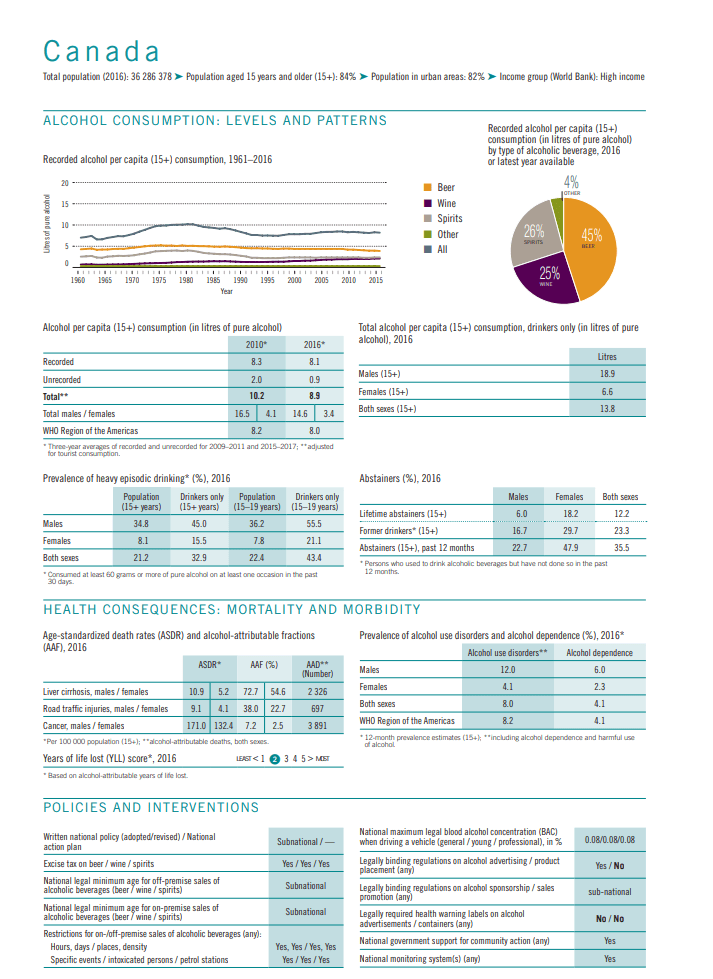Ontario, Canada changed their alcohol control policy in 2015, allowing for alcohol to be sold in grocery stores. A study was conducted by the University of Waterloo to analyze how this policy change affected adolescents.
In the study the researchers, over four years, examined the alcohol consumption of more than 2,000 youth from grades nine to eleven – comparing with data from before the policy change. The study found that in terms of alcohol use Canadian adolescents are heterogenous. There were four groups identified: abstainer, lower risk alcohol user, periodic alcohol user and higher risk alcohol user. The higher risk alcohol users were those who consumed alcohol one to three times a week and engaged in binge alcohol use two to four times a month.
Analysis of the data found that after the policy change to make alcohol more available more youth consumed alcohol in more high-risk patters:
- Adolescents who were originally abstinent were 75% more likely to transition directly to the higher risk category.
- The higher risk group were observed to maintain their high-risk behavior longer comparative to control groups.
… even these small changes indicate the different impacts of the policy change on subgroups of the population and may indicate to policymakers the potential negative impact of policy change on one narrow subgroup of the population,” said Mahmood Gohari, an author of the study and post-doctoral fellow in the School of Public Health and Health Systems at the University of Waterloo, as per Kitchener Today.
Mahmood Gohari, author of the study, post-doctoral fellow, School of Public Health and Health Systems, University of Waterloo
The study shows how policy changes can heavily impact sub-groups in the society.
The findings are especially concerning as a previous study by the University of Waterloo in November, 2019 found that early alcohol onset predicts harm in later life. According to that study,
- Teens who started alcohol use between 13 to 14 years of age were more likely to be alcohol users and to engage in heavy episodic alcohol use later in life, compared to teens who started alcohol use at 18 years or older.
- Teens who started alcohol use at 8 years were more likely to be alcohol users, binge on alcohol and mix alcohol with energy drinks later in life than teens who started alcohol use at 18 years of older.
Alcohol harm and policy in Canada
Evidence shows that alcohol is a much bigger problem in Canada than opioids and yet the response by the federal government to the alcohol crisis remains flawed.
It is estimated that annually alcohol causes:
- 15,000 deaths,
- 90,000 hospital admissions,
- 240,000 years of life lost, and
- An economic toll of $15 billion, which is greater than that from either tobacco use or from cannabis, opioids and all illegal substances combined.

As WHO data further details, at least 3,800 cancer deaths are due to alcohol in Canada, every year and 12% of Canadian men have an alcohol use disorder. Among minors, almost a quarter of the alcohol consumers engage in heavy episodic alcohol use.
Despite the obvious harm Canada does not have a national alcohol policy. In fact the federal government of Canada has been largely ignoring alcohol policy making in the country.
There is an urgent need for a strong federal alcohol policy in Canada to significantly reduce alcohol consumption, to curb related harm and to close the loopholes in the current policy. Such a policy should follow evidence-based alcohol policy solutions such as recommended by the WHO through the three best buys including increasing taxes, regulating availability and banning alcohol advertising, promotions and sponsorship.